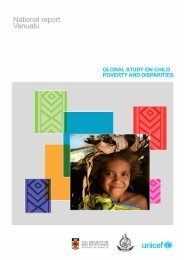A Strategic Assessment of the Children's Services Industry
A Strategic Assessment of the Children's Services Industry
A Strategic Assessment of the Children's Services Industry
- No tags were found...
Create successful ePaper yourself
Turn your PDF publications into a flip-book with our unique Google optimized e-Paper software.
STRATEGIC ASSESSMENT OF THE CHILDREN’S SERVICES INDUSTRYIn May 2006, children with additional needs as a proportion <strong>of</strong> all children in child care (allservice types) was 16.4 per cent predominately made up <strong>of</strong> children from culturally diversebackgrounds (11.0 per cent) followed by child with a disability (2.8 per cent) and <strong>of</strong>Aboriginal/Torres Strait Islander (1.7 per cent) (DEEWR, 2008a).When looking at <strong>the</strong> economic literature a number <strong>of</strong> important relationships and trends werenoted. A study conducted by <strong>the</strong> National Centre for Social and Economic Modelling atUniversity <strong>of</strong> Canberra, showed school age children are increasingly making use <strong>of</strong> formalcare, even when o<strong>the</strong>r factors were compared; children residing in capital cities were morelikely to use formal care than children in o<strong>the</strong>r areas, possibly reflecting fewer formal careservices for this group in rural areas; no significant differences were noted for <strong>the</strong> use <strong>of</strong>formal care by family income categories (Cassells and McNamara, 2006).A study <strong>of</strong> demand for child care and household labour supply by Doiron and Kalb (2005),concluded that non-parental child-care costs in Australia are low on average; <strong>the</strong> costs varysubstantially across households depending on <strong>the</strong> presence <strong>of</strong> preschool children and on <strong>the</strong>labour supply <strong>of</strong> parents; <strong>the</strong> demand function showed a substantial and negative-priceelasticity for formal care; and a 10 per cent increase in <strong>the</strong> price <strong>of</strong> child care reduces <strong>the</strong>participation rate by approximately 0.5 per cent for lone parents and 0.2 per cent for marriedwomen (Doiron and Kalb, 2005).The Kalb and Lee (2007) study on child care use and labour supply (an update to <strong>the</strong> Doironand Kalb 2005 study), data from wave 2 <strong>of</strong> <strong>the</strong> Household, Income and Labour Dynamics inAustralia (HILDA) survey and <strong>the</strong> Survey <strong>of</strong> Income and Housing Costs (SIHC) were used.The study found that for couples and sole parents, more formal child care is required whenyoung children are present, particularly 1-4 year olds (Table 5.4). Informal child care costswere found to be highest for children aged 3 and 4 due to attendance at preschools.Table 5.4. Percentage using care by age <strong>of</strong> <strong>the</strong> youngest child and labour force status inWave 2 <strong>of</strong> HILDA (2002)Age <strong>of</strong> youngest child 0-2 3-4 5-9 10-11 TotalCouple families: Two workers 83.0 92.1 64.1 46.2 70.9Couple families: One worker 43.3 49.1 37.6 10.4 40.7Couple families: No Worker 37.2 32.6 18.5 0.0 27.8All Couple families 60.7 71.5 54.2 35.% 57.1Sole Parents: One worker 93.0 84.0 80.6 74.6 81.2Sole Parents: Non worker 43.0 62.3 20.2 3.1 35.0All Sole Parents 55.1 69.8 55.2 54.0 57.6Source: Kalb and Lee (2007)Kalb and Lee (2007) found that increasing <strong>the</strong> mo<strong>the</strong>r’s labour supply by one hour willrequire 0.21 extra formal hours <strong>of</strong> child care and 10 cents <strong>of</strong> extra costs in informal care, <strong>the</strong>effect is stronger for sole parents. The study also measured <strong>the</strong> labour supply sensitivity tochanges in prices paid and net costs (i.e. prices less <strong>the</strong> subsidies using 2002 figures). Theyfound that parents with preschool child were quite sensitive to price changes, and more so if<strong>the</strong>y were sole parents. They concluded that a 1 per cent rise in prices will lead to a drop in<strong>the</strong> hours worked by married women with preschool child <strong>of</strong> 0.02 hours and 0.58 hours forsole parents, and if <strong>the</strong>y are on low wages as well, <strong>the</strong> drop is more significant at -.03 hoursand 0.93 hours respectively (Kalb and Lee, 2007).49
















